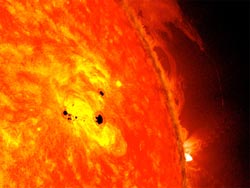NASA's SDO Observes Fast-Growing Sunspot

The bottom two black spots on the sun, known as sunspots, appeared quickly over the course of Feb. 19-20, 2013. These two sunspots are part of the same system and are over six Earths across. This image combines images from two instruments on NASA's Solar Dynamics Observatory (SDO): the Helioseismic and Magnetic Imager (HMI), which takes pictures in visible light that show sunspots and the Advanced Imaging Assembly (AIA), which took an image in the 304 Angstrom wavelength showing the lower atmosphere of the sun, which is colorized in red. Credit: NASA/SDO/AIA/HMI/Goddard Space Flight Center <br>
Over the course of Feb. 19-20, 2013, scientists watched a giant sunspot form in under 48 hours. It has grown to over six Earth diameters across but its full extent is hard to judge since the spot lies on a sphere not a flat disk.
The spot quickly evolved into what's called a delta region, in which the lighter areas around the sunspot, the penumbra, exhibit magnetic fields that point in the opposite direction of those fields in the center, dark area.
This is a fairly unstable configuration that scientists know can lead to eruptions of radiation on the sun called solar flares.
Karen C. Fox
NASA’s Goddard Space Flight Center
Media Contact
All latest news from the category: Physics and Astronomy
This area deals with the fundamental laws and building blocks of nature and how they interact, the properties and the behavior of matter, and research into space and time and their structures.
innovations-report provides in-depth reports and articles on subjects such as astrophysics, laser technologies, nuclear, quantum, particle and solid-state physics, nanotechnologies, planetary research and findings (Mars, Venus) and developments related to the Hubble Telescope.
Newest articles

Microscopic basis of a new form of quantum magnetism
Not all magnets are the same. When we think of magnetism, we often think of magnets that stick to a refrigerator’s door. For these types of magnets, the electronic interactions…

An epigenome editing toolkit to dissect the mechanisms of gene regulation
A study from the Hackett group at EMBL Rome led to the development of a powerful epigenetic editing technology, which unlocks the ability to precisely program chromatin modifications. Understanding how…

NASA selects UF mission to better track the Earth’s water and ice
NASA has selected a team of University of Florida aerospace engineers to pursue a groundbreaking $12 million mission aimed at improving the way we track changes in Earth’s structures, such…





















